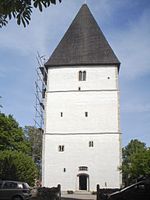20:
144:, and in 1250, he became regent and father of the king. It remains unclear if Ingrid Ylva was still alive at this point, though it is believed that she was. However, she does not seem to have played any part at the royal court, and probably preferred to stay within her estates. She is said to have married again, to an unnamed man with whom she had a son, Elof Vingad Pil, while other sources claim she remained unmarried.
176:
She was widely regarded for her ability to foretell the future. Legend claims, that on her deathbed she predicted that her line would succeed to the
Swedish throne, as long as her head was held high. Legend says, that because of this, her son, the regent, buried her standing upright, inside the tower
168:
was subjected to a surprise attack from the enemies of the family, Ingrid Ylva rushed to the top of the church tower, and, from there, she ripped open a pillow full of feathers which spread across the land and turned into knights in armour. These magical stories were far from slander: in the 13th
169:
century, the witch trials were hundreds of years in the future, magic was not illegal and the ability to master magic was considered a great and admirable skill; there was a clear separation between white and black magic; and not even black magic was yet connected to the
63:. The exact years of her birth and death are unclear; a traditional year quoted for her death is 26 October 1252; it is also considered, though, that this was the date of her burial, and that she had actually died in 1251.
96:
79:. She was married to Magnus Minnesköld of Bjälbo, possibly as his second wife. Several of his sons, born or raised by Ingrid Ylva, would come to hold positions of power when grown:
173:
or punishable by death, as it would become later. Her name was widely known long before her son became regent, and her alleged magical skill was highly admired.
132:
as the head of the family, due to her sons being minors. She attended the church from her favourite place in the church tower, to which she had once donated a
195:
Christer Öhman (Swedish): Helgon, bönder och krigare. Berättelser ur den svenska historien (Saints, farmers and warriors. Stories from the history of Sweden)
164:, which she used for good purposes and for her family's good fortune. A lot of stories were told about her magical skills. One legend said that once, when
221:
Christer Öhman: "Helgon, bönder och krigare. Berättelser ur den svenska historien" (Saints, peasants and warriors. Stories from the
Swedish history)
253:
248:
101:
263:
258:
92:
141:
136:; according to tradition, she often lived in this tower during insecure times. In 1234, her son
107:
243:
238:
49:
8:
161:
80:
115:
232:
88:
207:
157:
137:
133:
111:
72:
60:
84:
45:
165:
129:
53:
76:
19:
153:
57:
215:
Jan
Guillou: "Häxornas försvarare" (Defender of the witches)
170:
177:with which she had had such a close relationship.
230:
128:–1210, she most likely managed her estates in
201:
156:, and possibly in her time, as a so-called
191:
189:
147:
18:
231:
118:, and later had his son elected king.
23:The Bjälbo Church tower of Ingrid Ylva
186:
160:; she was said to be able to master
13:
14:
275:
152:Ingrid Ylva is known in various
142:Ingeborg Eriksdotter of Sweden
1:
254:12th-century Swedish nobility
249:13th-century Swedish nobility
122:
38:
31:
66:
7:
10:
280:
264:12th-century Swedish women
259:13th-century Swedish women
75:, she was the daughter of
202:References and literature
180:
24:
148:Ingrid Ylva in legend
44:–1255) was a Swedish
22:
108:bishops of Linköping
56:and the mother of
25:
16:Swedish noblewoman
140:married Princess
50:Magnus Minnesköld
271:
224:
218:
212:
196:
193:
127:
124:
105:
43:
40:
36:
33:
279:
278:
274:
273:
272:
270:
269:
268:
229:
228:
222:
216:
210:
204:
199:
194:
187:
183:
150:
125:
121:As a widow, in
99:
69:
41:
34:
17:
12:
11:
5:
277:
267:
266:
261:
256:
251:
246:
241:
227:
226:
219:
213:
203:
200:
198:
197:
184:
182:
179:
149:
146:
116:Jarl of Sweden
68:
65:
48:, the wife of
15:
9:
6:
4:
3:
2:
276:
265:
262:
260:
257:
255:
252:
250:
247:
245:
242:
240:
237:
236:
234:
220:
214:
209:
206:
205:
192:
190:
185:
178:
174:
172:
167:
163:
159:
155:
145:
143:
139:
135:
131:
119:
117:
113:
109:
103:
98:
94:
90:
86:
82:
78:
74:
71:According to
64:
62:
59:
55:
51:
47:
29:
21:
244:1250s deaths
239:1180s births
223:(in Swedish)
217:(in Swedish)
211:(in Swedish)
208:Runeberg.org
175:
151:
120:
106:both became
89:Westrogothia
70:
35: 1180s
27:
26:
158:white witch
126: 1208
100: [
73:Olaus Petri
61:Birger Jarl
42: 1250
28:Ingrid Ylva
233:Categories
85:lawspeaker
46:noblewoman
67:Biography
77:Sune Sik
154:legends
114:became
83:became
225:(1994)
166:Bjälbo
138:Birger
130:Bjälbo
112:Birger
58:regent
54:Bjälbo
181:Notes
171:Devil
162:magic
104:]
97:Bengt
81:Eskil
134:bell
110:and
95:and
93:Karl
87:in
52:of
235::
188:^
123:c.
102:sv
91:,
39:c.
37:–
32:c.
30:(
Text is available under the Creative Commons Attribution-ShareAlike License. Additional terms may apply.
